Waking through the gardens on the way to the Memorial, we were impressed with the number of butterflies flitting among the wild prairie gardens they had there. When I was young (many years ago in Emmetsburg, IA), we used to try to catch butterflies. We were woefully unsuccessful but I remember darting around the yard after the multitudes of smaller white and yellow butterflies interspersed with monarchs, the king of the butterflies. Butterflies seem so scarce these days that seeing several monarchs in one scene was amazing. I kept my camera primed trying to catch one on a flower but they do flutter-by fast. But, I finally caught one lifting off a flower.

The gardens are only one part of the Hoover Memorial which consists of his boyhood home restored by Herbert and Lou Hoover, his wife, a blacksmith shop built to resemble his father’s, an old Quaker Meeting House where he went to church and a school which he attended. There are several other old homes in the area which are privately owned but which make up the Historical Area around his home.
Here is his home which had 2 rooms and a summer kitchen attached to the rear. Note the picket fence. Homes along main thoroughfares as his was needed fences to keep out all the animals being driven into town via the main streets. It was not a large home, especially with 3 children, only 14’ x 20’ and only 1 story. On the right is the ‘multi-purpose’ room used as kitchen, living room, dining room, study hall, etc. Gary is standing at the front door and, with a few strides, he could go out the back door. The other room, the bedroom, was a bit smaller.
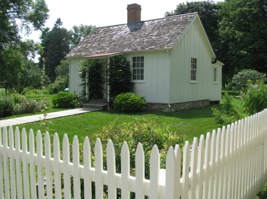
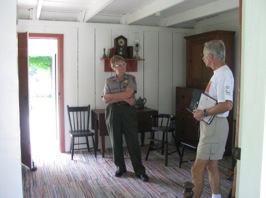
Here is the one-room school where he attended. Note the I-Pads on the desks. Pretty modern, huh? No, as you can see, those are slates.
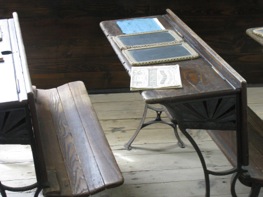
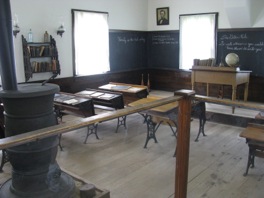
Herbert Hoover’s Presidency has never been considered very successful and that’s too bad. He had an unusual childhood, a very successful career as an engineer, was considered the savior of Europe during WWI and had many accomplishments as a Secretay of Commerce in the 1920’s. He should have quit while he was ahead. However, he was thought so highly of that he easily won election in 1928, and then it all unraveled. Being an Iowan, I’d like the only Iowa President to be one of the best but it was not to be.
His father was a successful businessman and his mother a very prominent Quaker highly regarded in her own church and asked to speak at others. Unfortunately, his father died at the age of 34 and his mother a year later at 35. The three children, Bert, Mary and Theodore were finally divided up and Bert moved to Oregon to live with an uncle.
Obviously you can all read his biography and I don’t want to bore you here but I was impressed with several facets of his life prior to the Presidency.
He graduated with an engineering degree from Stanford and moved to Austrailia to look for minerals, gold being one of the primary ones. He was only there a year but found a rich vein which he convinced his employers to buy for $1,000,000 but which returned $65,000,000 in gold. At one point he had his own engineering business with 175,000 employees from Siberia to Peru. Not too shabby.
He met his fuure wife, Lou Henry, while they were both at Stanford studying (she was the only female in geology). He proposed by wire on his way from Austrailia to China, she accepted his proposal by wire and they were married in 1899. They lived in China where they survived the Boxer Rebellion. We saw a picture where Lou was wearing a pistol because the Boxers had broken into their compound. Finally, the American army prevailed and they were able to leave China.
During and after WWI, he finally found his calling. First, after the war began, he helped organize the return of 120,000 Americans from Europe: tourists, students, executives, etc. Hoover led five hundred volunteers in the distribution of food, clothing, steamship tickets, and cash, sometimes even supplying them with loans which almost all paid back. Next, he organized food drives to save millions of starving people in Europe. He especially organized the Committee for Relief of Belgium and obtained and imported millions and millions of tons of foodstuffs to distribute to the Belgians. The Committee had to ensure also that the Germans did not get the cloth from the bags of food to use in their war effort. The Belgian women took these bags and stitched them up for their homes, many praising Hoover as a noble American.
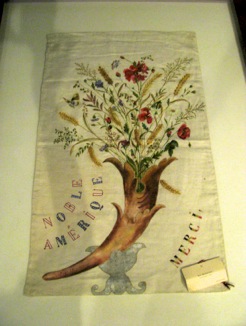
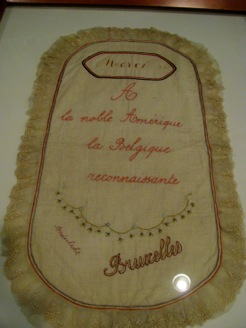
Between 1914 and 1917 when America entered the war, he worked tirelessly, crossing the North Sea 40 times to arrange safe routes with Germany for the food to get through. He became an international hero and the Belgian city of Leuven named a prominent square Hooverplein after him.
Third, when America entered the war in 1917 he turned his attention to America. President Wilson appointed him head of the US Food Administration where his goal was to grow more and more food and to preserve certain food supplies for shipment to soldiers at the front. He encouraged Americans to plant gardens to grow their own foodstuffs. He established set days where Americans could avoid eating certain foods and save them for soldiers. Meatless Mondays and Wheatless Wednesdays and ‘when in doubt eat potatoes’ were his exhortations. All of this was dubbed ‘Hooverizing’ but it preseved food for the soldiers and enabled all of America to help in the war effort.
As Secretary of Commerce during the 1920’s his desire for efficiency led him to promote standardization of such things as screws, bolts, wiring, radio and air waves, shingles, etc. Imagine trying to patch your roof and trying to find the same size of shingles used in the first roofing.
He ended the 12-hour workday in the steel industry which then spread to other industries. Thank you , Mr. Hoover.
He worked with the Savings and Loan banks to devise a long-term mortgage to promote home ownership. He called his campaign the ‘Own Your Own Home’ campaign.
When the Great Mississippi Flood of 1927, displaced 1 1/2 million people and flooded millions of acres, the governors of 6 states asked for Hoover specifically to help them with relief efforts.
Hoover also played a key role in major projects for navigation, irrigation of dry lands, electrical power, and flood control.
He did an amazing job as Secretay of Commerce. Some in Washington said he was the Secretary of Commerce and the’ Under-Secretarty of Everything Else.’
He should have stopped there and retired.
There is also a magnificent tall grass prairie on the grounds on the path to the gravesite where both Hoover and Lou are buried.

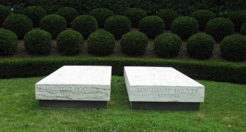

No comments:
Post a Comment